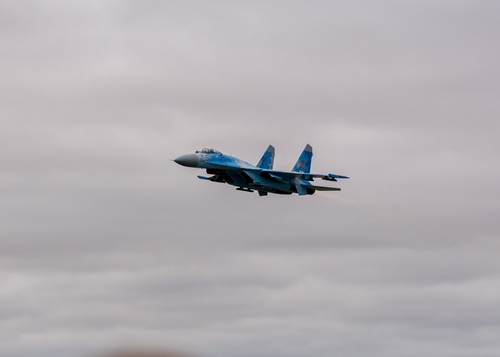Belgium (Brussels Morning Newspaper), In the depths of eastern Ukraine, under the shroud of a seemingly impenetrable night, an unusual tranquility pervaded the airspace—a stark contrast to the relentless turmoil that had defined the region for years. This silence, however, was not born of peace but of a remarkable shift in the dynamic of warfare between Ukrainian forces and their formidable adversary, Russia.
Within the span of a mere fortnight, the Ukrainian Air Force achieved a series of unexpected and significant victories against Russian air power, a feat that reverberated through the world of defense strategy and military analysis. The downing of at least 14 Russian fighters, along with a Beriëv A-50, signaled a turning point in a conflict marked by its brutal intensity and high stakes.
At the heart of these developments is the Sukhoi Su-34, a cornerstone of Russian tactical bombing capabilities and a symbol of Moscow’s military prowess. With a price tag of $50 million per unit, the loss of approximately 37 of these aircraft represents not just a significant financial blow but also a profound operational setback for the Russian Air Force.
The Ukrainian successes are intricately tied to two pivotal shifts in the theatre of war. Firstly, the timing coincided with a Russian push at Avdiivka, a town whose capture in mid-February underscored the fierce contest over every inch of Eastern Ukraine. The Russian offensive, characterized by the deployment of “hover bombs” from their bombers, illustrated a tactical evolution designed to breach Ukrainian defenses from the air.
However, the effectiveness of these air strikes came at a steep cost to the aggressors, underscored by the high-risk maneuvers required to deploy glide bombs effectively. The necessity for Russian pilots to approach closer to the front lines, thereby increasing their exposure to Ukrainian air defenses, marked a critical vulnerability in their strategy.
The second, perhaps more decisive factor in the shifting tide of aerial combat, was the Ukrainian Air Force’s strategic targeting of Russian radar and command aircraft. The downing of such specialized units, essential for operational command and control, significantly impaired the Russian Air Force’s situational awareness and combat effectiveness over the contested regions.
In the aftermath of these losses, the Russian military apparatus finds itself at a crossroads, forced to reassess the balance between the pursuit of tactical gains on the ground and the sustainability of its air operations. The Institute for the Study of War (ISW) suggests that, despite the setbacks, Moscow remains determined to leverage its current momentum in the Donbas, even at the expense of further aircraft losses.
This determination is further fueled by the broader context of the conflict, including the dire ammunition shortages faced by Ukrainian forces—a consequence of interrupted U.S. military supplies. The strategic implications of these shortages cannot be overstated, offering the Russian offensive a window of opportunity to press its advantage in a region that has borne the brunt of conflict since 2014.
Yet, the resilience of Ukrainian air defense, exemplified by the use of advanced systems like the Norwegian NASMS and the American Patriot, poses a continued threat to Russian air superiority. The specifics of these engagements, shrouded in operational secrecy, hint at a complex interplay of tactics, technology, and intelligence.
Beyond the immediate theater of aerial combat, the war extends to strategic infrastructure, with suspected Ukrainian sabotage operations targeting Russia’s extensive railroad network. These actions, aimed at disrupting the logistical backbone of Russian military operations, signify a broader dimension of the conflict, where the lines between front line engagements and strategic depth blur.
The recent developments in the skies over Eastern Ukraine and beyond reflect not just the tactical nuances of modern warfare but also the enduring resilience and adaptability of the Ukrainian defense forces. Amidst the geopolitical complexities and the human cost of ongoing hostilities, the struggle for air superiority emerges as a critical facet of a conflict that continues to shape the contours of international security and regional stability.
Opinions expressed in the op-ed section are solely those of the individual author and do not represent the official stance of our newspaper. We believe in providing a platform for a wide range of voices and perspectives, even those that may challenge or differ from our own. As always, we remain committed to providing our readers with high-quality, fair, and balanced journalism. Thank you for your continued support.Sincerely, The Brussels Morning Team



